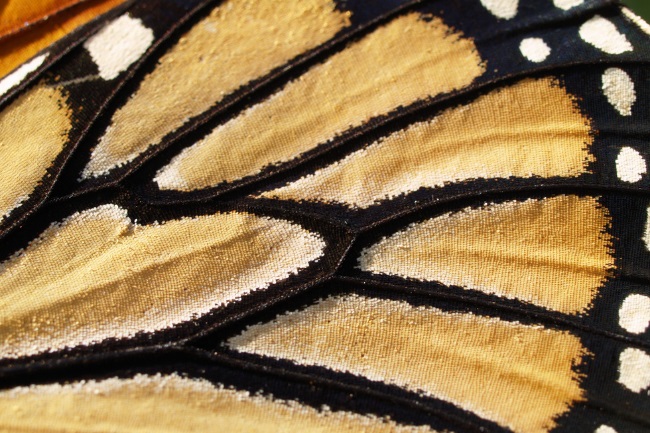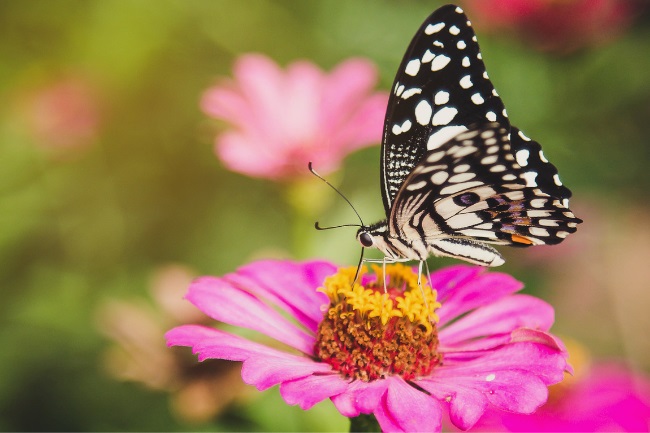Unfortunately, a butterfly’s wings do not grow back once they are damaged or removed. Being very fragile the wings are easily injured. A small amount of damage can usually be survived but too much can cause the butterfly to be unable to fly.
Contents
What are butterfly wings made of?

Butterfly wings are often beautifully coloured and highly patterned. They come in many different shapes and sizes and can lift these tiny creatures across seas, over mountains and even high up into the atmosphere.
Yet, what would you say if you knew that a butterfly’s wings are made of the same substance as our toenails. Chitin is a type of protein that creates both our fingernails and hair and a butterfly’s wings.
These wings come in two pairs, either side of the body, divided into the forewings and hindwings. Attached to the butterfly’s body at the thorax, these wings are made up of two thin layers of chitin covered in tiny scales.
Scales may be something we associate more with reptiles but look very closely at butterflies wings and there they are. The scales are adapted hairs, though many butterflies also have hairs across part of their wings.
The purpose of these scales is multiple. The most obvious is of course the colours they display. These colours are largely created in two ways. Firstly the scales can contain pigments that give them colours, or secondly, the structure of the scale can be arranged so as to refract light, making it appear to be a different colour. The blue of the morpho butterfly is a classic example of refraction.
The colours of butterflies wings have many functions. They can aid in camouflage, or warn predators that the butterfly is poisonous. They can help to attract mates, or they can mimic larger animals or even other species of butterflies.
Alongside their function in signalling, a butterfly’s scales provide an important practical function, they help to insulate and warm the butterfly. Many of us will have spotted butterflies basking in the sun. This may seem like they are just chilling out but this is actually an important job to help warm their bodies enough to fly. Like all insects, butterflies cannot produce their own heat, and therefore the warmth of the sun is required for them to function.
A final, but equally important function of the scales is to help in evading capture. If you’ve ever touched butterflies wings you’ll have noticed the dust that is left behind on your finger. This dust is the remains of the tiny scales found on the butterflies wings. They break off easily when touched to allow the butterfly to escape the grasp of a predator or escape from a spider’s web.
However, while this may be a handy trick it isn’t one the butterfly can use too many times, as losing large amounts of scales could lead to its death.
Also read: Do Butterflies Mate for Life? Eternal Love or…
Why do butterfly wings break?
You may well have noticed the wonderfully bright colours of the butterflies in spring compared to the many tatty and worn individuals at the end of the year. Like us humans, butterflies age, the roughness of the world often causing their wings to become torn and scales to drop. With time they fade and become less bright.
As well as time, accidents can occur. Though a butterfly’s wings are strong and flexible they are easily damaged if caught by an animal, or accidentally snagged on a thorn. Small cuts and holes here and there can often be survived, and you’ll see plenty of butterflies still happily flying about with a small scratch or two.
Larger tears or missing wings can leave butterflies not being able to fly, however, which can leave them vulnerable to predators or unable to reach food.
For some butterflies, the damage can even occur early on, when they emerge from their chrysalis. Having emerged their wings need to be pumped up and allowed to dry. If something touches the wings while they are still wet that may be game over for the butterfly from day one.
Also read: Here’s How a Butterfly Flies When it Rains (Explained)
Can a butterfly’s wings grow back?

Sadly an adult butterfly isn’t able to repair or grow back its wings. Once the damage is done they either need to continue on despite it or they will succumb to the injury. This is one of the reasons it’s important not to handle butterflies, as any damage done to them is irreversible.
Repairing a butterfly’s wing is technically possible, however, as it is highly likely more damage will occur during the process it isn’t recommended to try unless non-intervention would lead to its death anyway.
| Butterfly Species | Regenerative Abilities |
|---|---|
| Painted Lady (Vanessa cardui) | Yes |
| Monarch (Danaus plexippus) | No |
| Red Admiral (Vanessa atalanta) | Partially |
| Common Buckeye (Junonia coenia) | Partially |
| Stage | Description |
|---|---|
| Injury | The butterfly sustains wing damage due to predation, accidents, or other factors. |
| Healing | The damaged wing undergoes a healing process where cells and tissues start repairing the wing structure. |
| Wing Bud Formation | Specialized cells called imaginal discs initiate the formation of a new wing bud, containing all the necessary structures for wing development. |
| Wing Development | The wing bud grows and differentiates, forming the complex wing structures, including veins, scales, and color patterns. |
| Wing Unfolding | The newly developed wing expands and unfolds, gradually gaining its full size and shape. |
| Maturation | The regenerated wing matures and hardens, allowing the butterfly to resume normal flight and other activities. |
Also read: 6 Essential Practices to Help a Dying Butterfly
A delicate explorer
Despite the fragile nature of a butterfly’s wings, these creatures are surprisingly resilient. Some like the monarch butterfly head out on great migration, others spend icy winters beneath dead tree bark and emerge resplendent in spring.
While they may look like creatures that will break as soon as the world touches them they’ve conquered almost every continent on the world, and are found across almost every habitat, from rainforests to deserts. So perhaps these tiny insects are just that much tougher than they first appear.

